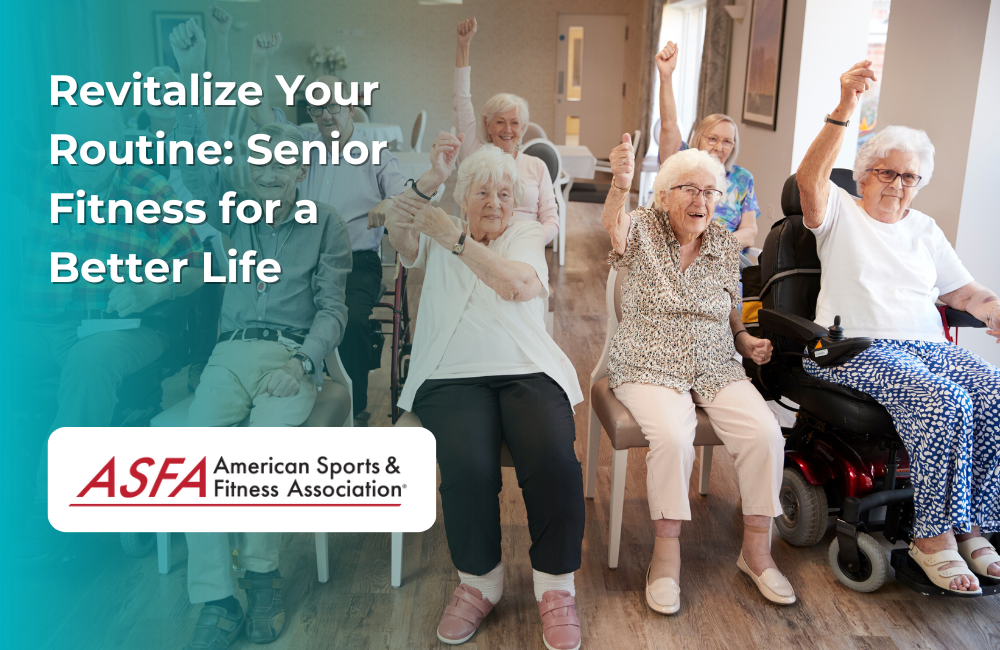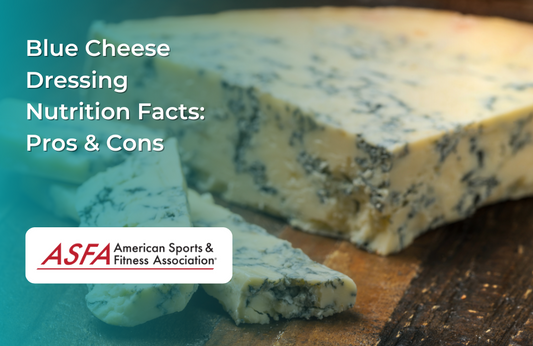The golden years are often viewed as a time to relax and reflect, but they also offer a unique chance for revitalization, particularly through physical fitness. This period is an excellent opportunity to embrace the concept of 'active aging', which emphasizes staying engaged and energetic. For seniors, maintaining an active lifestyle isn’t just about staying healthy—it’s about enriching life with energy, independence, and vitality. “Revitalize Your Routine: Senior Fitness for a Better Life” aims to inspire seniors to embrace fitness, showing how certified Senior Fitness Instructors by the American Sports and Fitness Association (ASFA) play a crucial role in helping seniors lead active and fulfilling lives.
Why Senior Fitness Matters
Fitness in the senior years goes beyond the traditional concept of exercise. It is a gateway to:
-
Improved physical health: Stronger muscles, enhanced flexibility, and better cardiovascular health.
-
Mental and emotional well-being: Regular exercise can reduce stress, anxiety, and depression.
-
Independence: Staying active helps seniors maintain their ability to perform daily tasks without assistance.
-
Social engagement: Participating in group fitness or recreational activities helps combat loneliness and fosters social connections.
Many seniors are dispelling the myth that aging limits physical activity. With the right guidance, they are discovering that functional fitness can be both enjoyable and transformative. Certified Senior Fitness Instructors offer tailored fitness programs that meet the specific needs of older adults, making fitness accessible, safe, and rewarding.
The Role of Senior Fitness Instructors
Senior Fitness Instructors are more than just trainers—they are mentors, motivators, and educators. They offer personalized training to meet the specific needs of each individual. They bring specialized knowledge of age-related challenges and guide seniors through safe, effective workouts. Their expertise allows them to design personalized fitness programs that cater to the unique physical, emotional, and health needs of each client. From understanding how the body changes with age to offering modifications for mobility issues, these instructors ensure that every senior’s fitness journey is both safe and impactful.
How Senior Fitness Instructors Help:
-
Tailored exercise plans: Individualized routines that match the client's fitness level, health conditions, and goals.
-
Functional exercises: Movements that mimic everyday tasks, improving mobility, strength, and balance.
-
Motivation and support: Instructors keep seniors motivated and engaged, offering encouragement and tracking progress.
-
Nutritional guidance: Advice on diet and hydration to complement physical activity and promote overall health.
The Benefits of Regular Exercise for Seniors
Regular physical activity, including mobility exercises, provides a wide range of benefits for seniors, improving not only physical health but also emotional well-being and social connections.
Key Benefits Include:
-
Improved Mobility and Flexibility: Regular exercise helps maintain joint mobility, reducing stiffness and pain, and enhancing the ability to move freely.
-
Stronger Muscles and Bones: Resistance and weight-bearing exercises strengthen muscles and bones, helping to prevent conditions like osteoporosis.
-
Better Balance: Balance exercises reduce the risk of falls, a leading cause of injury in older adults.
-
Enhanced Mental Well-being: Physical activity boosts mood, reduces anxiety, and helps maintain cognitive function.
-
Increased Social Interaction: Group fitness classes provide a social outlet, helping seniors stay connected and combat feelings of isolation.
Types of Exercise for Seniors
As we age, it’s essential to incorporate a variety of exercises into our routine to maintain overall health and fitness. Here are some essential exercises and cardiovascular options for seniors:
Essential Exercises and Cardiovascular Options:
-
Strength Training: Incorporating strength training exercises into your routine can help increase strength, flexibility, and balance. Focus on exercises that target all major muscle groups, such as squats, lunges, and leg press. These exercises not only build muscle but also support bone health, which is crucial for preventing osteoporosis.
-
Cardiovascular Exercise: Regular cardiovascular exercise can help improve heart health, reduce blood pressure, and increase endurance. Options include brisk walking, swimming, cycling, and dancing. These activities get your heart pumping and blood flowing, enhancing overall cardiovascular fitness.
-
Tai Chi: Tai chi is a low-impact, slow-moving exercise that can help improve balance, flexibility, and strength. It’s also an excellent way to relieve tension and reduce stress. The gentle, flowing movements of tai chi make it an ideal exercise for seniors looking to enhance their physical and mental well-being.
-
Fall Prevention: Exercises that focus on balance and flexibility can help prevent falls. Consider incorporating exercises like single-leg squats, heel-to-toe walking, and balance poses into your routine. These exercises enhance stability and coordination, reducing the risk of falls and related injuries.
-
Low-Impact Aerobics: Low-impact aerobics, such as water aerobics or step aerobics, can be an excellent way to improve cardiovascular health without putting excessive strain on the joints. These activities provide a fun and social way to stay active while protecting your joints from high-impact stress.
Creating an Effective Exercise Routine
Creating an effective exercise routine can be challenging, but with a few simple steps, you can build a sustainable routine that meets your needs and goals. Here’s how:
Steps to Build a Sustainable Routine:
-
Set Goals: Start by setting specific, achievable goals for your exercise routine. Do you want to improve cardiovascular health, increase strength, or relieve tension? Having clear goals in mind will help you create a focused routine that keeps you motivated and on track.
-
Choose Exercises: Select exercises that align with your goals and fitness level. Consider working with a personal trainer or fitness coach to help you choose exercises that are safe and effective. Tailoring your exercise routine to your individual needs ensures that you get the most benefit from your workouts.
-
Create a Schedule: Develop a schedule that works for you and your lifestyle. Aim to exercise at least 3-4 times per week, with at least one day of rest in between. Consistency is key to seeing progress, so find a routine that you can stick to long-term.
-
Start Slow: Don’t try to do too much too soon. Start with short, manageable workouts and gradually increase duration and intensity as you become more comfortable. This approach helps prevent injury and allows your body to adapt to the new activity level.
-
Track Progress: Keep track of your progress by using a fitness tracker, journal, or mobile app. Monitoring your progress can help you stay motivated and engaged. Seeing your improvements over time can be incredibly rewarding and encourage you to keep going.
Tailoring Fitness Programs to Individual Needs
A one-size-fits-all approach doesn’t work in senior fitness. Adaptive fitness is crucial for addressing the unique needs of each individual. Senior Fitness Instructors understand the importance of customizing workout plans to each individual’s abilities, limitations, and goals.
Personalized Fitness Programs Include:
-
Low-Impact Exercises: Activities like walking, swimming, and yoga are gentle on the joints, making them ideal for seniors.
-
Functional Training: Exercises designed to improve the ability to perform everyday tasks, such as reaching, bending, and lifting.
-
Balance and Stability Exercises: These exercises help prevent falls, which is critical for maintaining independence.
-
Safe and Effective Movements: Senior Fitness Instructors ensure that exercises are performed correctly to minimize the risk of injury.
Overcoming Challenges and Staying Motivated
Staying motivated and overcoming challenges is crucial to maintaining a successful exercise routine. Here are some strategies for long-term success:
Strategies for Long-term Success:
-
Find a Workout Buddy: Exercising with a friend or family member can help keep you motivated and accountable. Having a workout partner makes exercise more enjoyable and provides mutual support.
-
Reward Yourself: Set small rewards for yourself when you reach certain milestones or complete a challenging workout. Rewards can be a great way to stay motivated and celebrate your achievements.
-
Mix it Up: Vary your routine to avoid boredom and prevent plateaus. Try new exercises, take a different class, or workout outdoors. Keeping your routine fresh and exciting helps maintain your interest and enthusiasm.
-
Focus on Progress: Celebrate small victories and focus on progress, rather than perfection. Remember, every step forward is a step in the right direction. Acknowledge your efforts and improvements, no matter how small they may seem.
-
Seek Support: Don’t be afraid to seek support from a fitness professional, healthcare provider, or support group. Having a network of support can help you stay motivated and overcome challenges. Professional guidance can provide valuable insights and keep you on the right track.
By incorporating these strategies, you can overcome obstacles and stay committed to your fitness journey, ensuring long-term success and a healthier, more vibrant life.
The Importance of Nutrition and Hydration
Physical activity is just one aspect of maintaining health in the senior years—proper nutrition and hydration are equally important. As we age, our bodies require different nutrients and are more prone to dehydration, making it essential to incorporate a balanced diet and adequate fluid intake.
Key Considerations for Seniors:
-
Balanced Diet: Seniors should focus on nutrient-dense foods rich in vitamins, minerals, and fiber to support energy, bone health, and overall well-being.
-
Adequate Hydration: As the body ages, the sensation of thirst may diminish, making it important to encourage regular fluid intake, especially during and after exercise.
Senior Fitness Instructors can offer guidance on maintaining a diet that complements an active lifestyle, helping seniors fuel their bodies for optimal health and energy.
Leveraging Technology in Senior Fitness
Technology is becoming an increasingly valuable tool in promoting senior fitness. Virtual fitness classes offer seniors the opportunity to participate in guided workouts from the comfort of their homes. With advancements in fitness tracking and online resources, seniors can stay engaged with their health and fitness even from home.
Useful Technology for Seniors Includes:
-
Fitness Trackers and Apps: Wearable devices can track steps, heart rate, and calories burned, motivating seniors to stay active and monitor their progress.
-
Online Fitness Classes: For seniors who may have difficulty attending in-person sessions, online classes offer a convenient and accessible way to exercise. These classes allow seniors to participate in guided workouts from the comfort of their home.
Technology provides an additional layer of support for seniors, making it easier to stay motivated and maintain consistency in their fitness routine.
Embracing Senior Fitness for a Healthy, Vibrant Life
Holistic wellness is about more than just staying active—it’s about embracing a lifestyle that promotes health, well-being, and joy in the senior years. Certified Senior Fitness Instructors play a pivotal role in this transformation, offering the expertise and encouragement seniors need to incorporate fitness into their daily lives.
Why Senior Fitness is Transformative:
-
Redefines Aging: Fitness helps seniors break free from the constraints of age, encouraging them to discover new strengths and capabilities.
-
Builds Resilience: Regular exercise fosters both physical and mental resilience, allowing seniors to handle life's challenges with confidence.
-
Creates Social Bonds: Group fitness activities offer a sense of community and connection, vital for emotional well-being.
-
Improves Quality of Life: Engaging in fitness leads to a better, more fulfilling life by enhancing both physical health and mental clarity.
Conclusion: Add Life to Your Years Through Senior Fitness
The journey of senior fitness is about more than physical activity—it's about revitalizing life, embracing new opportunities, and enhancing well-being in every sense. With the guidance of a certified Senior Fitness Instructor, seniors can enjoy the benefits of personalized exercise routines, nutritional support, and expert advice, all tailored to their unique needs.
Revitalizing your routine through fitness is a powerful way to not only add years to your life but also life to your years. Whether through group classes, individual training, or leveraging technology, the possibilities for staying active and healthy are endless. It's never too late to start your fitness journey, and the rewards go far beyond improved health. They lead to greater independence, emotional well-being, and a renewed zest for life.
So, let this be a call to action for all seniors: embrace the opportunity to revitalize your routine and experience the vibrant, fulfilling life that senior fitness offers. With the right support, you can unlock your full potential and enjoy every moment of your golden years.





